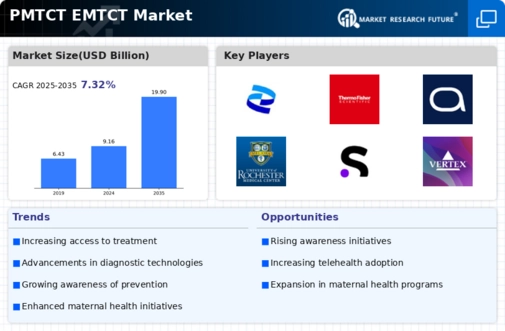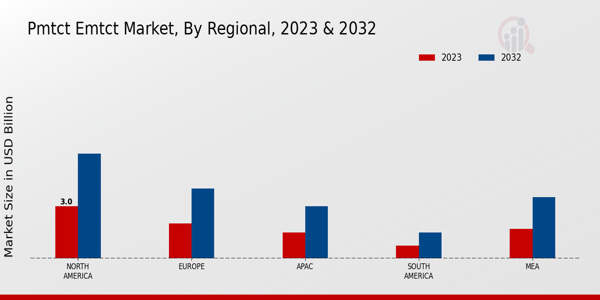Market Growth Projections
The Global PMTCT EMTCT Market Industry is poised for substantial growth, with projections indicating a market size of 19.9 USD Billion by 2035. This anticipated growth is underpinned by various factors, including increasing awareness, advancements in medical technologies, and robust government initiatives. The market is expected to experience a compound annual growth rate (CAGR) of 7.32% from 2025 to 2035, reflecting the ongoing commitment to eliminating mother-to-child transmission of HIV. This growth trajectory suggests a positive outlook for stakeholders involved in PMTCT and EMTCT efforts, emphasizing the importance of sustained investment and innovation in this critical area.
Rising Global HIV Prevalence
The rising global prevalence of HIV remains a significant driver for the Global PMTCT EMTCT Market Industry. With millions of individuals living with HIV, the need for effective PMTCT and EMTCT strategies becomes increasingly urgent. Regions with high HIV rates, particularly sub-Saharan Africa, are focusing on comprehensive healthcare solutions to prevent transmission during pregnancy and breastfeeding. This ongoing challenge necessitates sustained investment in healthcare infrastructure and services, thereby propelling market growth. The urgency to address these public health concerns is reflected in the projected market size of 9.16 USD Billion in 2024, highlighting the critical need for continued efforts in this area.
Government Initiatives and Funding
Government initiatives and funding are pivotal in advancing the Global PMTCT EMTCT Market Industry. Many countries are allocating substantial resources towards maternal health programs aimed at eliminating mother-to-child transmission of HIV. For instance, national health budgets increasingly prioritize PMTCT services, which include free access to antiretroviral drugs for pregnant women. This financial commitment not only enhances service delivery but also encourages healthcare providers to adopt best practices. As a result, the market is projected to grow to 19.9 USD Billion by 2035, underscoring the impact of government support on public health outcomes.
Collaborative Global Health Efforts
Collaborative global health efforts are instrumental in driving the Global PMTCT EMTCT Market Industry. International organizations, non-governmental organizations, and local governments are increasingly working together to implement effective PMTCT and EMTCT programs. These partnerships facilitate knowledge sharing, resource allocation, and the establishment of best practices across different regions. For example, initiatives like the Global Fund and PEPFAR have significantly contributed to the scaling up of PMTCT services in various countries. Such collaborations are expected to enhance the overall effectiveness of interventions, thereby fostering market growth and improving health outcomes for mothers and children.
Advancements in Medical Technologies
Innovations in medical technologies play a crucial role in shaping the Global PMTCT EMTCT Market Industry. The development of rapid diagnostic tests, antiretroviral therapies, and improved maternal healthcare practices have enhanced the effectiveness of PMTCT and EMTCT programs. For example, the introduction of point-of-care testing has facilitated timely interventions for HIV-positive pregnant women, thereby reducing transmission rates. As these technologies continue to evolve, they are likely to drive market growth, with an anticipated compound annual growth rate (CAGR) of 7.32% from 2025 to 2035, indicating a robust future for the industry.
Increasing Awareness of PMTCT EMTCT Programs
The growing awareness of prevention of mother-to-child transmission (PMTCT) and elimination of mother-to-child transmission (EMTCT) programs is a key driver in the Global PMTCT EMTCT Market Industry. Governments and health organizations are actively promoting these initiatives to reduce the incidence of HIV transmission during childbirth. For instance, campaigns in various countries have led to increased testing and treatment rates among pregnant women. This heightened awareness is expected to contribute significantly to the market, with projections indicating a market size of 9.16 USD Billion in 2024, reflecting the global commitment to maternal and child health.














